England’s record-high NHS waiting list will only continue to rise in the wake of the Covid crisis, the Health Secretary warned today.
Sajid Javid said at least 7million people who ‘ordinarily would have come forward’ for medical treatment stayed away during the pandemic.
Health chiefs now want those patients to ‘come back’ but accept it will cause a huge increase in demand that will cause waiting lists to rise.
Data released by NHS England today revealed 5.45million patients were waiting for routine treatment in June. It was the highest-ever figure since official records began in 2007.
Doctors also warned the backlog, exacerbated by the pandemic, could double in the next year.
This is despite the health service getting close to returning to pre-pandemic levels of activity, while juggling coronavirus pressures. Analysts say the mixture has left some hospitals are ‘busier than ever’.
Medics claim the NHS is ‘running on empty’ after 20 months of ‘unrelenting pressure’ and now faces ‘unprecedented’ demand for this time of year.
Other figures underlining the severity of the summer crisis revealed:
The ambulance service answered its highest number of 999 alerts ever in July, with more than one million calls made — the equivalent of one every two-and-a-half seconds;Average ambulance response times for life-threatening calls such as cardiac arrests rose to their highest levels since 2017;Just 77.7 per cent of A&E patients were treated within four hours — the lowest rate since records began.
Mr Javid said: ‘Everyone understands why hospital waiting lists have risen. The NHS has rightly focused on Covid in this horrible pandemic and that has meant, sadly, that waiting lists have risen.
‘We estimate there’s probably some seven million people that ordinarily would have come forward to the NHS that stayed away, understandably, during the height of the pandemic.
‘We want those people to come back. I don’t know how many will come back but, even if half of them came to the NHS – and can I just stress I really want people that need to be seen by the NHS to know the NHS is there for them and they should come forward – but as they do I think waiting lists will rise because there will be a huge increase in demand.
‘And I think, again, people understand that.’
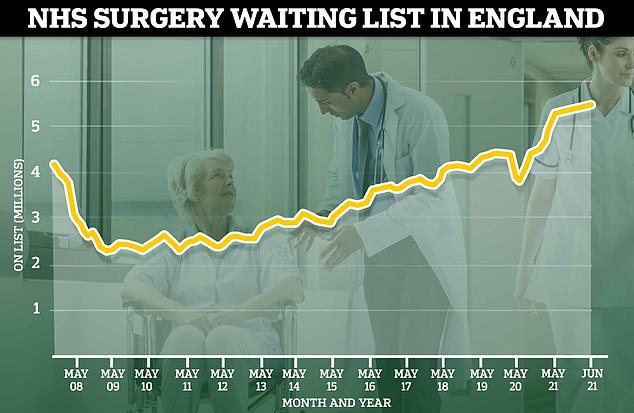
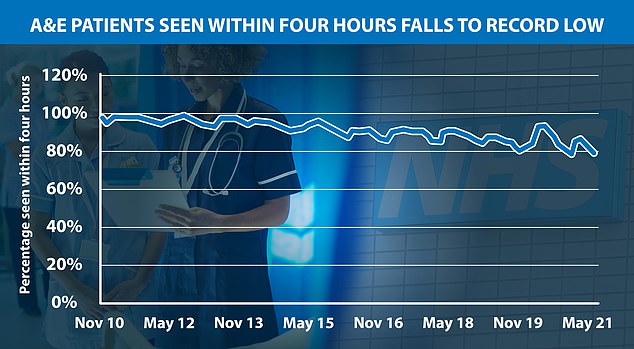
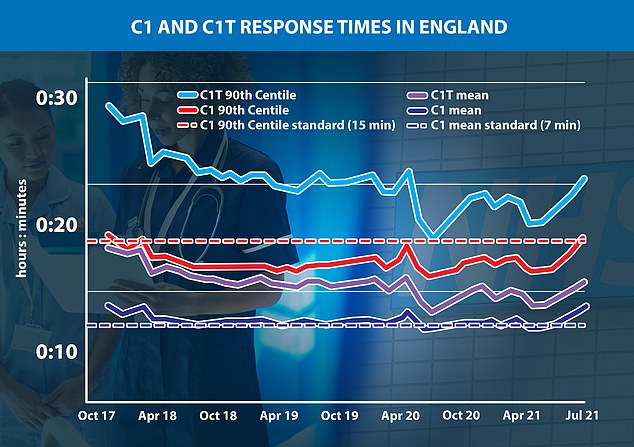
The average ambulance response time for category one cases — which include life-threatening conditions, such as cardiac arrest —was was 8 minutes and 33 seconds (bottom dark purple line). And one in 10 of these callers had to wait as long as 15 minutes and 15 seconds for help (red line). Both figures are the longest they have been since 2017. Guidelines set out ambulances should arrive with an average of seven minutes for serious incidents and within 15 minutes in 90 per cent of cases (shown in dotted lines)
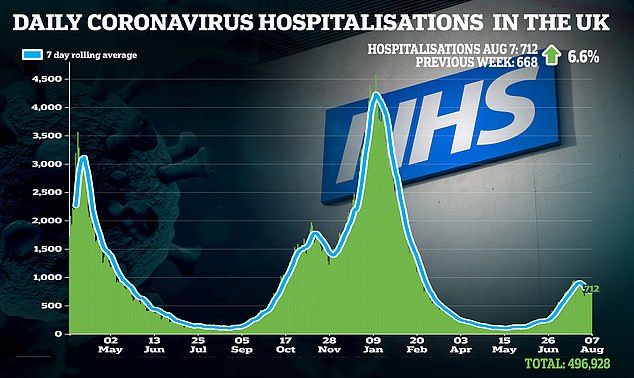
Despite an average of 761 patients being admitted to hospital over the last seven days – a sixth of the number at the peak in January – NHS services are still under pressure
Nearly 1.2million people have been left waiting at least SIX MONTHS for NHS treatment in England, analysis shows amid warning that some hospitals are ‘busier than ever’
Nearly 1.2million NHS patients have faced waits of at least six months for treatment due to the Covid backlog, analysis has revealed.
The figure, reflecting the English health service’s position in May, is five times higher than pre-pandemic levels.
It highlights just how badly the virus has hit hospitals, which cancelled thousands of operations during the darkest days of the crisis to make room for the infected.
Joint replacements, eye treatment and brain surgery are among the procedures that have been hit by delays.
Under the NHS’s own rulebook, all patients are supposed to start treatment within 18 weeks of being referred.
NHS data, analysed by the Guardian, revealed 210,000 patients waiting six months required trauma and orthopaedic services, such as hip and knee replacements.
And more than 130,000 were waiting for eye treatment, ear, nose and throat services and general surgery.
Nearly 90,000 people were waiting for gynaecological services — nearly double the figure for the same month last year and five times higher than May 2019.
The Nuffield Trust warned the backlog will take ‘years’ to clear.
Advertisement
The NHS England figures did offer some promising signs that hospitals are finally making a dent in the coronavirus-fuelled backlog.
Under the NHS’s own rulebook, patients are supposed to start treatment within 18 weeks of being referred.
The number of patients waiting longer than that mark fell in June, from almost 1.73million to slightly over 1.70million.
Meanwhile, year-long waits have also fallen.
More than 335,000 people in England hadn’t been seen within 52 weeks in May — compared to just shy of 305,000 in June.
For comparison, little over 1,000 patients were left waiting over a year for routine care before the pandemic struck.
Professor Stephen Powis, national medical director for NHS England, said: ‘NHS staff have made effective use of the additional resources made available to us to recover services which were inevitably disrupted during the pandemic.
‘And we are continuing to tackle the Covid backlog.
‘This has come as services have seen some of the highest ever number of patients coming forward for care during the summer months, all at the same time as delivering the biggest and most precise vaccine roll-out in our history.
‘I would urge anyone who needs NHS to come forward through NHS 111 Online so that staff can help you with the best option for your care.’
Hospitals were forced to cancel tens of thousands of operations during the darkest days of the pandemic to focus on treating Covid patients.
The controversial decision had a huge knock-on impact on on cancer care and other vital services.
Despite the success of Covid vaccines, the third wave has still added pressure to an already stretched health service.
An average of 675 patients are admitted to hospital with Covid every day at the minute, NHS figures show.
All infected patients have to be isolated from others to control the spread of the virus.
Official data shows 275,271 people were admitted for routine treatment in hospitals in June, the highest since last March (207,754).
However, the figure for June is still lower than the same month in 2019, before the services were affected by the pandemic (289,203).
It means growing numbers (around 68.6 per cent) are now receiving NHS treatment within 18 weeks. Before the pandemic hit, the figure stood at around 84 per cent.
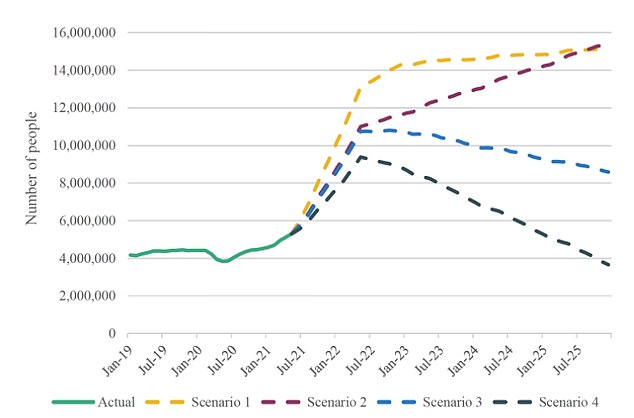
The Institute for Fiscal Studies revealed modelled how long the waiting list for NHS care in England would be under different scenarios. Even in the best care scenario, the waiting list peaked at nine million in 2022 and did not return to pre-pandemic levels until 2025. This scenario would involve just 70 per cent of patients who missed treatment during the pandemic coming forward and NHS capacity being 5 per cent higher in 2021 and 2020 compared to 2019 and 10 per cent higher from 2023 to 2025
Number of people falling ill with Covid in Britain IS ticking upwards
The number of people falling ill with Covid every day in Britain has started to tick upwards, a symptom-tracking study has claimed.
Data from the ZOE Covid symptom study shows daily cases fell 2.12 per cent in the week ending August 7 from the 46,905 recorded the previous week.
But the rate of decline slowed down significantly, with experts suggesting infections could be levelling out or about to start rising again.
Professor Tim Spector, an epidemiologist at Kings College London and lead scientist on the study, said it is too early to tell whether the levelling off of cases will turn into another spike.
He warned the slight increase in cases in over-60s could be caused by ‘waning immunity’ among those jabbed earlier in the year but admitted it could be caused by more weddings and social events where the young and elderly have been mixing over summer.
He said: ‘The decrease in cases that we saw last week appears to have faltered over the last few days, and we’re seeing signs of an uptick.
‘However, it’s too early to say if this is a start of another steep increase like the one we saw in July. While it’s reassuring to see loosened restrictions haven’t caused cases to sky rocket, it’s more difficult to predict the future.
‘Cases remain relatively low in the fully vaccinated group, which is a sign that vaccines are working and keeping the spread at bay.’
Meanwhile, separate data from NHS Test and Trace revealed the number of people testing positive for the virus fell five per cent to 179,748 over the week ending August 4.
Both sets of data are lagging indicators, with more recent Department of Health figures showing cases have started to tick up again this week, rising one per cent in a week to 29,612 yesterday.
Experts are at odds as to whether the slight increase this week could flatten out over the rest of the month.
Professor Steven Riley, an infectious disease expert at Imperial College London and member of the Spi-M modelling subgroup of SAGE, warned cases could start to pick up again in September when children return to school.
Advertisement
Meanwhile, the ambulance service in England answered more than 1million calls in July for the first time ever.
This equates to around 32,400 calls every day — the equivalent of one every two-and-a-half seconds.
The average response time for category one calls — which include life-threatening conditions, such as cardiac arrest — was 8 minutes and 33 seconds. And one in 10 callers had to wait as long as 15 minutes and 15 seconds for help.
Both figures are the longest since 2017.
Guidelines set out ambulances should arrive with an average of seven minutes for serious incidents and within 15 minutes in 90 per cent of cases.
Separate data for A&E revealed 2.16million patients visited casualty units in July — a figure similar to levels seen before Covid hit.
And just 77.7 per cent were seen within four hours — the lowest figure since records began.
Dr Nick Scriven, ex-president of the Society for Acute Medicine, warned the health service is ‘pretty much running on empty after 20 months of unrelenting pressure culminating now in what is really unprecedented demand at this time of year’.
He said: ‘Staff are stressed and exhausted seeing very little light at the end of any proverbial tunnel as we approach a winter that is already being predicted to be severely challenging.
‘Wards are full of very sick people with or without Covid infection and the severity of their illnesses and the subsequent dependency of their needs has made it very hard to discharge them safely if they require any additional social care.
‘We have seen data this week that shows the number of hospital bed days occupied by people who are medically ready to be discharged has been rising and is now higher than in the winter.
‘We desperately need a system fix that allows patients to move more efficiently from emergency departments through acute medical units and onto base wards and discharge as that is currently a major problem.
‘We have spent years – or decades – and millions of pounds trying to “fix the front door” of hospitals yet it will not improve however much resource you throw at it until the backdoor is sorted – and that means tackling social care provision.’
Professor Neil Mortensen, President of the Royal College of Surgeons of England said: ‘The summer is traditionally a quieter time for the NHS, so surgeons had hoped we could catch up on the huge backlog of operations postponed because of Covid.
‘However, this summer, the pressure on emergency departments hasn’t let up. A volatile mix of pressures is hindering the surgical recovery.
‘With more than 5,000 people in hospital with Covid there is still too much pressure on hospital beds, because these patients must be kept separate and distanced from others.
‘Along with staff shortages caused by the app pinging people, it’s been incredibly difficult for some places to get back to pre-pandemic levels of operating.
‘Waiting lists will continue to grow without significant investment in a more sustainable system, adapted to a country where the virus remains endemic.
Labour’s Shadow Health Secretary Jonathan Ashworth said: ‘Today’s NHS stats reveal a health service in a summer crisis struggling without the resources and staff needed to deliver quality care on time.
‘Behind every statistic is a desperately worried patient languishing longer in pain and distress at risk of serious illness or permanent disability.
‘Bringing down waiting times must be the priority for ministers, not the distracting top-down reorganisation Sajid Javid is pushing ahead with.
‘Instead ministers must deliver a credible long term rescue plan for our NHS and social care sector, guaranteeing the staffing and modern technology that are so desperately needed to bring down waiting times, avoid a winter crisis and provide the exceptional care patients deserve.’
NHS Providers chief executive Chris Hopson told BBC Breakfast that despite lower levels of Covid patients being admitted to hospital, the health service was still struggling.
He said: ‘What we can’t do is magic treatment out of thin air. What we need is money, but we also need to invest that money in a larger workforce, and that is fundamental to getting through this backlog.
‘We simply won’t get through it quick enough unless that funding and investment is there and that is the challenge that the Chancellor and the Prime Minster have to answer, probably over the next three or four, five weeks.’
Mr Hopson warned yesterday the pressure on ambulance services is ‘a particular concern’.
He said: ‘What’s particularly striking is how busy all parts of the NHS are – hospitals, community and mental health services, GPs and primary care.
‘There is a particular concern about the unprecedented pressure on ambulance services, the fact that this has lasted for a number of weeks, and the impact this is having on both staff and patients.
‘We now have some trust chief executives, particularly in the ambulance sector, telling us that this is now the busiest it has ever been.’
Health Secretary Sajid Javid said last month he was ‘shocked’ when told waiting lists could even go as high as 13million.
But a report released on Sunday revealed figures could top that number and rise to 14million by next autumn and then continue rising.
The Institute for Fiscal Studies (IFS) calculated the number of people coming forward for care could overtake the number being treated, if the millions of patients who put off seeking treatment during the pandemic come forward.
Its most optimistic modelling shows the number of people waiting for treatment in England would peak at nine million in 2022 and only return to pre-pandemic levels in 2025.
And under its most concerning scenario — if NHS capacity does not return to pre-pandemic levels by 2025 — the waiting list would hit 15million by 2025.
Source link : https://www.dailymail.co.uk/news/article-9886721/NHS-backlog-hits-record-high-5-45million-drops-waiting-year-care.html











